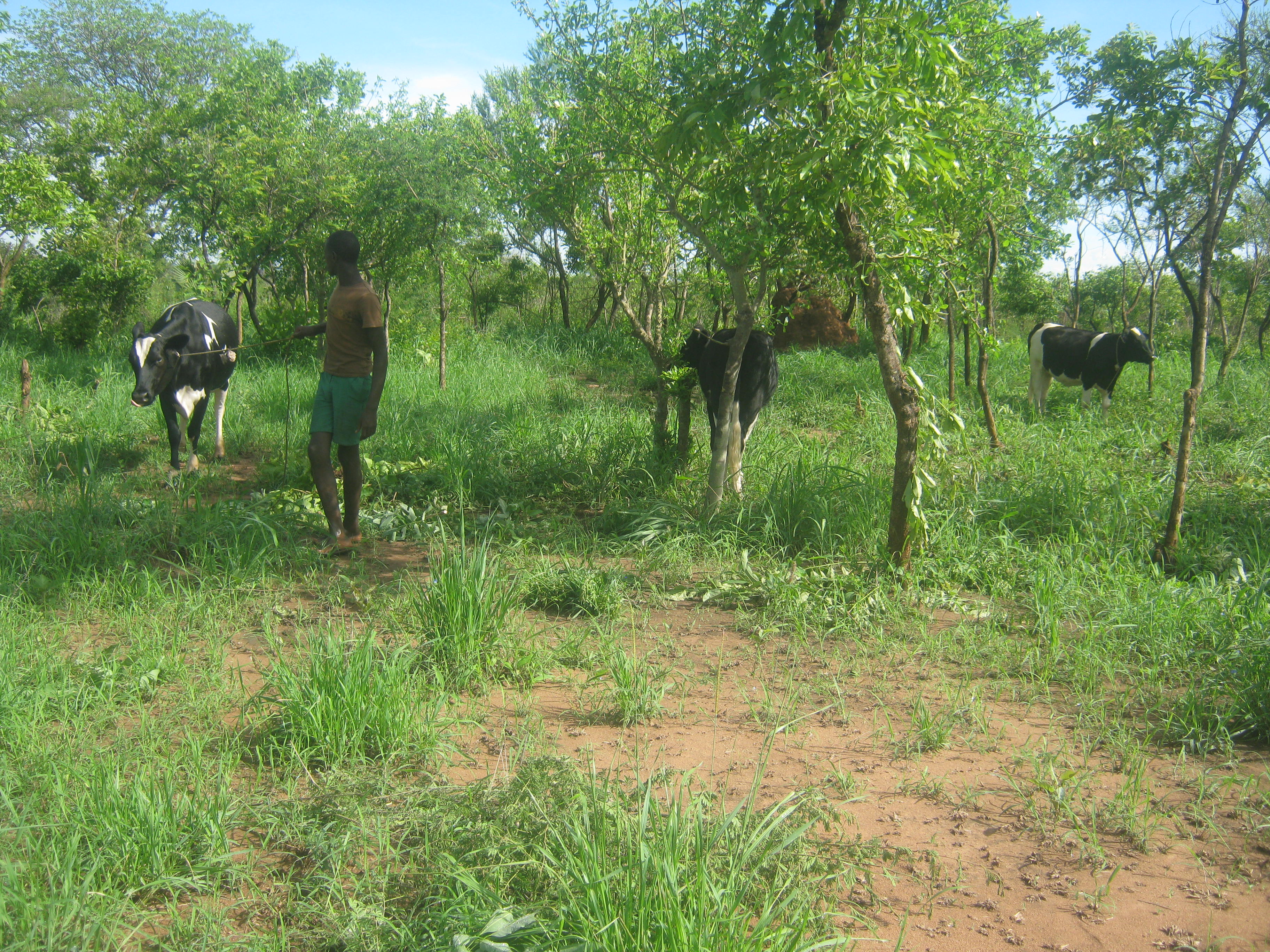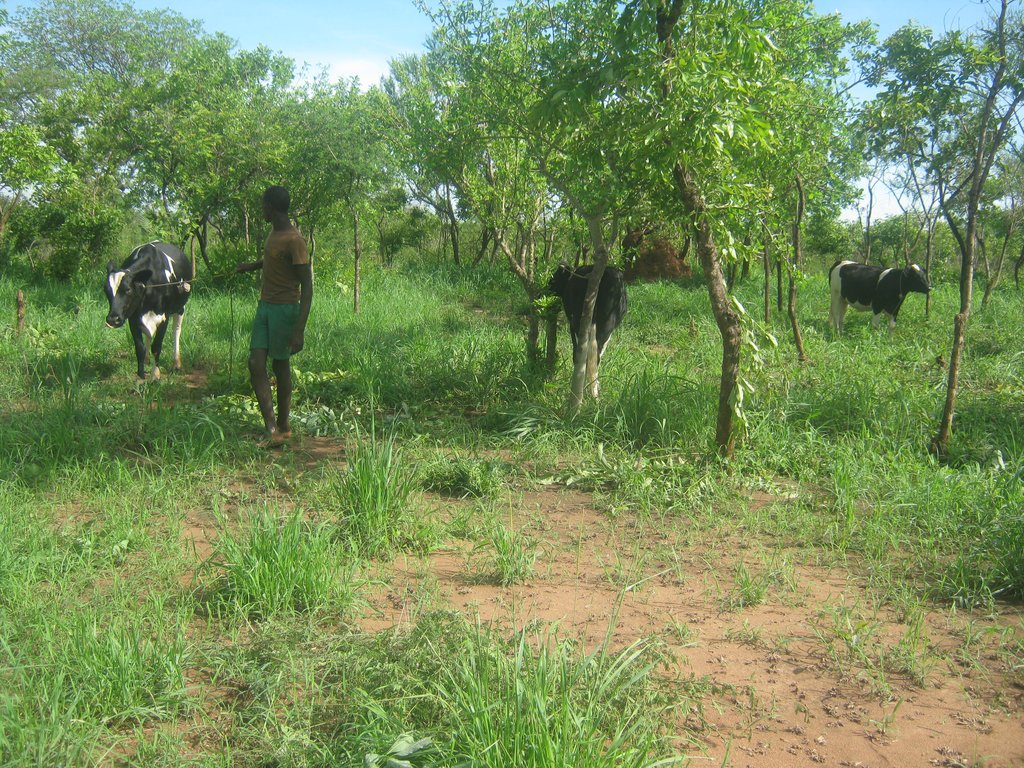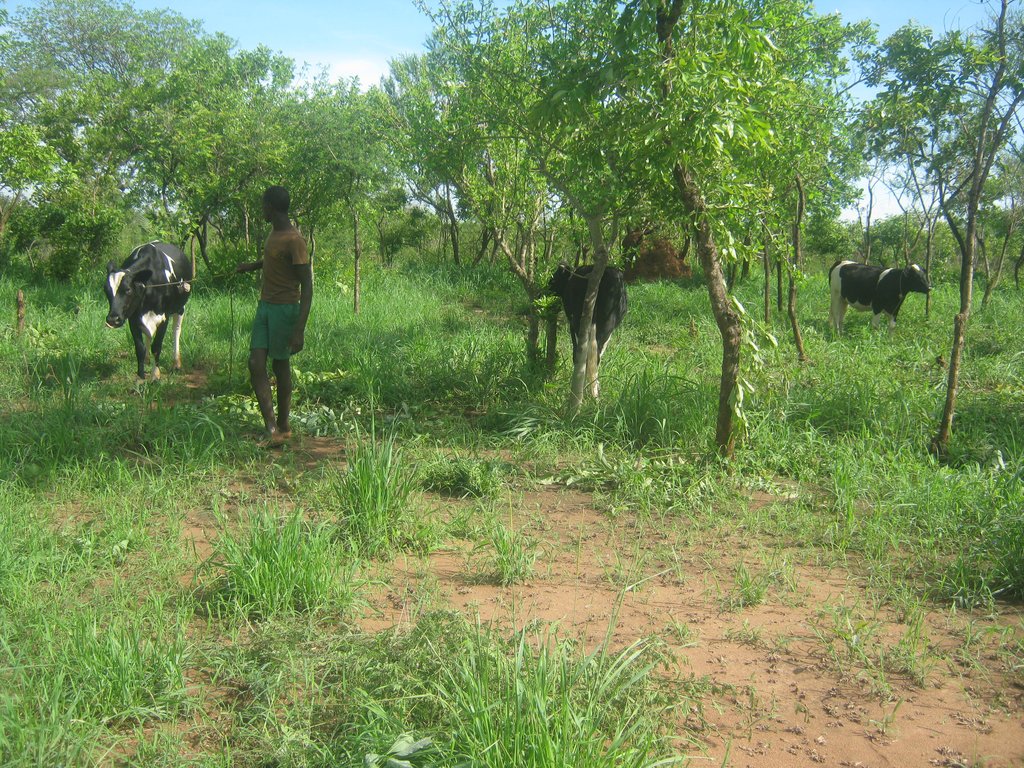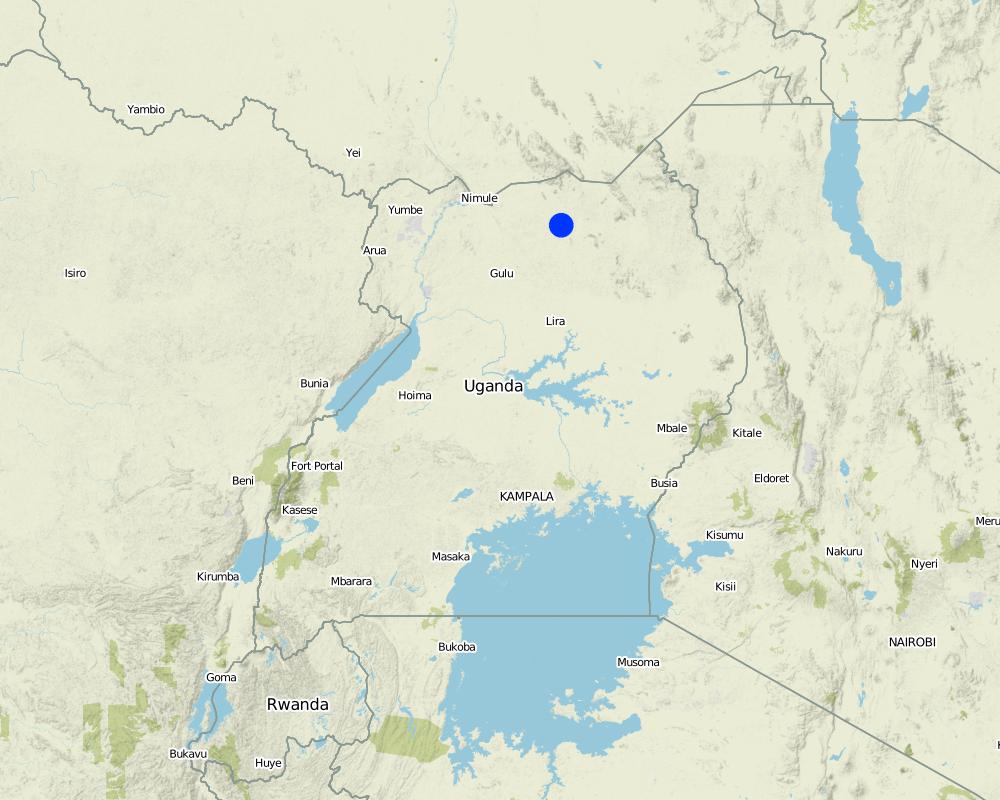Reclamation of indigenous pastures for dairy farming [乌干达]
- 创建:
- 更新:
- 编制者: betty adoch
- 编辑者: JOY TUKAHIRWA
- 审查者: John Stephen Tenywa, Nicole Harari, Renate Fleiner, Stephanie Jaquet, Rima Mekdaschi Studer
Lum pi dyang cak
technologies_2321 - 乌干达
查看章节
全部展开 全部收起1. 一般信息
1.2 参与该技术评估和文件编制的资源人员和机构的联系方式
关键资源人
土地使用者:
Geoffrey Olum
+256-782927838
kitgum district, labongo amida sub county, lukwo village
c/o 39 kitgum district
乌干达
有助于对技术进行记录/评估的项目名称(如相关)
Scaling-up SLM practices by smallholder farmers (IFAD)有助于对技术进行记录/评估的机构名称(如相关)
CDE Centre for Development and Environment (CDE Centre for Development and Environment) - 瑞士1.3 关于使用通过WOCAT记录的数据的条件
(现场)数据是什么时候汇编的?:
11/05/2017
编制者和关键资源人员接受有关使用通过WOCAT记录数据的条件。:
是
1.4 所述技术的可持续性声明
这里所描述的技术在土地退化方面是否存在问题,导致无法被认为是一种可持续的土地管理技术?:
否
注释:
Reclaimed pastures from crop land are used for grazing the cows.
2. SLM技术的说明
2.1 技术简介
技术定义:
Dairy cattle (Friesian) are grazed on indigenous pastures to promotes conservation of the indigenous grass species (guinea grass), which protects the soil against soil erosion and promotes biodiversity.
2.2 技术的详细说明
说明:
Indigenous pasture-based dairy farming is a balance between managing the pasture and the cows to maximize sustainable profit and promotes conservation of the indigenous grass species which protects the soil against soil erosion and promotes biodiversity. Northern Uganda has tropical savannah climate which receives moderate amount of rainfall ranging from 750-1000mm per annum. This is sometimes characterised by prolonged dry spells which hamper other economic activities like crop production. Therefore, to avoid the climatic shocks, this technology was introduced by the land user to diversify his economic activity other than only relying on crop production. The land user is a typical subsistence farmer whose major source of income depends on dairy farming to support his livelihood.
In this SLM technology, indigenous pastures are conserved for dairy farming. This is due to the existence of savannah grassland vegetation which provide abundant pastures for cattle grazing. This has favoured the rearing of Friesian cow on a flat landscape. A 30x40meters land was highly preserved for this technology. Five (5) cows are kept on this grazing field occupied by natural pasture (elephant grass) that the land user conserve. These grass are nutritious and the cows healthily and freely graze on them during wet and dry season. However, their movement is controlled by the headsman to avoid crop damage.
In order to maintain these grasses, during dry season, the land user creates a fire line around the conserved grazing area. This is to prevent the spread of wild fire from the nearby bush since it is a serious occurrence in the community. The conserved grass dries up during dry season but the dairy cows graze on it and can still produce high volume of milk as during the wet season. A cow produces daily 15 to 20 litters, they are milked twice a day and the milk is taken to town for sale. Soda ash are given to the cows to raise their appetite for pastures and water. Cows are source of milk, which is sold to generate revenue to the farmer for school fees, medications and cow dung is applied in orchard gardens and tree plantations to boost soil fertility.
To establish this technology, One Friesian cow were donated to the land user by a government project and a grazing field was secured which used to be for crop growing. Water tank placed on the grazing field. The grasses were conserved for the cow and shrub trees also protected for shade. With the help of artificial insemination, more calves were produce and today the land user have five cows that freely graze the area although their movement is controlled by the headsman.
This technology conserve grasses which cover the soil from the effects of soil erosion, reduce incidence of wild fire in the area, the shrubs trees are also protected to provide shade to the cows in the grazing field which promotes farmer managed natural regeneration and the grazing cows spread dung around the field which boost soil fertility.
During dry spells pasture growth is retarded and also becomes less nutritious that makes the cows to become skinny and water shortages. Besides, these cows are prone to pests and disease attacks that requires constant monitoring and treatment.
2.3 技术照片
2.4 技术视频
注释、简短说明:
diary cow grazing on the natural pastures
日期:
19/05/2017
位置:
Kitgum District, Lukwor village,
摄影师的名字:
Betty Adoch
2.5 已应用该技术的、本评估所涵盖的国家/地区/地点
国家:
乌干达
区域/州/省:
Northern Uganda.
有关地点的进一步说明:
Kitgum Municipality
注释:
the GPS point indicate the land user farm site
Map
×2.6 实施日期
注明实施年份:
2012
如果不知道确切的年份,请说明大概的日期:
- 不到10年前(最近)
2.7 技术介绍
详细说明该技术是如何引入的:
- 通过项目/外部干预
注释(项目类型等):
knowledge provided by Dairy Development Authority (DDA).
3. SLM技术的分类
3.1 该技术的主要目的
- 改良生产
- 减少、预防、恢复土地退化
- 保护生态系统
- 保持/提高生物多样性
- 适应气候变化/极端天气及其影响
- 创造有益的经济影响
3.2 应用该技术的当前土地利用类型

牧场
粗放式放牧场:
- 经营牧场
集约放牧/饲料生产:
- 改良牧场
主要动物种类及产品:
exotic breed (Friesian cattle) for milk production.
注释:
artificial insemination done to acquire a calf.
如果由于技术的实施而导致土地用途发生变化,则在技术实施前说明土地利的用途。:
cropland
3.3 有关土地利用的更多信息
该技术所应用土地的供水:
- 雨养
注释:
pastures depends on rain for growth
每年的生长季节数:
- 2
具体说明:
cows are milk on a daily basis and one cows generates 15-20 litres of milk
牲畜密度(如相关):
Five (5) cows
3.4 该技术所属的SLM组
- 农业林学
- 畜牧业和牧场管理
- 改良植物品种/动物品种
3.5 技术传播
具体说明该技术的分布:
- 均匀地分布在一个区域
如果该技术均匀地分布在一个区域上,请注明覆盖的大致区域。:
- < 0.1 平方千米(10 公顷)
注释:
2 acres of land gazetted for grazing the cows.
3.6 包含该技术的可持续土地管理措施

植物措施
- V1:乔木和灌木覆盖层
- V2:草和多年生草本植物

管理措施
- M1:改变土地使用类型
注释:
crop production garden was converted into a grazing ground.
3.7 该技术强调的主要土地退化类型

土壤水蚀
- Wt:表土流失/地表侵蚀
- Wg:冲沟侵蚀/沟蚀

土壤风蚀
- Et:表土流失
- Ed:风蚀风积

生物性退化
- Bc:植被覆盖的减少
- Bh:栖息地丧失
- Bf:火灾的有害影响
注释:
Dairy farming protects the soil from human induced activities like crop cultivation which exposes the top soils for erosion.
3.8 防止、减少或恢复土地退化
具体数量名该技术与土地退化有关的目标:
- 防止土地退化
- 减少土地退化
注释:
promotes soil conservation
4. 技术规范、实施活动、投入和成本
4.1 该技术的技术图纸
4.2 技术规范/技术图纸说明
2 acres of land measuring 30x40 meters secured for grazing the cows. A kraal is constructed on the grazing field to accommodate the cows in the night. Pegging is done to prevent the cows from moving to cropland and after some time like afternoon the cows are shifted to another spot to graze. But also at time the cows are left to graze in the field with controlled movement. A kraal/shade is constructed, roofed with 5 pieces of iron sheet and supported by timbers that stands at a height of about 4meters.
4.3 有关投入和成本计算的一般信息
具体说明成本和投入是如何计算的:
- 每个技术区域
注明尺寸和面积单位:
2acres
其它/国家货币(具体说明):
UGX
注明美元与当地货币的汇率(如相关):1美元=:
3718.0
注明雇用劳工的每日平均工资成本:
3000shs
4.4 技术建立活动
| 活动 | 措施类型 | 时间 | |
|---|---|---|---|
| 1. | clearing thony trees | 植物性的 | dry season |
| 2. | regeneration of pastures | 植物性的 | dry season |
| 3. | constructing cattle shade | 植物性的 | dry and wet |
注释:
Dairy farming is easy to manage by a a farmer.
4.5 技术建立所需要的费用和投入
注释:
Its quite expensive at the initial stage of technology establishment but maintenance is easy.
4.6 维护/经常性活动
| 活动 | 措施类型 | 时间/频率 | |
|---|---|---|---|
| 1. | Slashing the over grown grass | 植物性的 | dry and wet |
| 2. | constant removal of thony trees | 植物性的 | dry and wet |
| 3. | Refilling the water tank | 管理 | wet and dry season |
| 4. | Rotational pegging | 植物性的 | Dry and wet seasons |
| 5. | Taking/returing of cows to kraal every evening | dry and wet seasons | |
| 6. | Replacing ropes to tie the cows during pegging | dry and wet seasons |
4.7 维护/经常性活动所需要的费用和投入(每年)
注释:
The management is easy by the farmer.
4.8 影响成本的最重要因素
描述影响成本的最决定性因素:
The labour for firebreaks during dry seasons and maintaining the farm.
5. 自然和人文环境
5.1 气候
年降雨量
- < 250毫米
- 251-500毫米
- 501-750毫米
- 751-1,000毫米
- 1,001-1,500毫米
- 1,501-2,000毫米
- 2,001-3,000毫米
- 3,001-4,000毫米
- > 4,000毫米
指定年平均降雨量(若已知),单位为mm:
900.00
有关降雨的规范/注释:
heavy rain in april, may, june, august, september and october. these reduces in july, november,december january , febuary and march.
注明所考虑的参考气象站名称:
kitgum weather station
农业气候带
- 半湿润
savanna climate where rainfall is moderate and unreliable with hot temperatures throughtout the year.
5.2 地形
平均坡度:
- 水平(0-2%)
- 缓降(3-5%)
- 平缓(6-10%)
- 滚坡(11-15%)
- 崎岖(16-30%)
- 陡峭(31-60%)
- 非常陡峭(>60%)
地形:
- 高原/平原
- 山脊
- 山坡
- 山地斜坡
- 麓坡
- 谷底
垂直分布带:
- 0-100 m a.s.l.
- 101-500 m a.s.l.
- 501-1,000 m a.s.l.
- 1,001-1,500 m a.s.l.
- 1,501-2,000 m a.s.l.
- 2,001-2,500 m a.s.l.
- 2,501-3,000 m a.s.l.
- 3,001-4,000 m a.s.l.
- > 4,000 m a.s.l.
说明该技术是否专门应用于:
- 不相关
关于地形的注释和进一步规范:
generally flat landscape.
5.3 土壤
平均土层深度:
- 非常浅(0-20厘米)
- 浅(21-50厘米)
- 中等深度(51-80厘米)
- 深(81-120厘米)
- 非常深(> 120厘米)
土壤质地(表土):
- 中粒(壤土、粉土)
土壤质地(地表以下> 20厘米):
- 中粒(壤土、粉土)
表土有机质:
- 中(1-3%)
如有可能,附上完整的土壤描述或具体说明可用的信息,例如土壤类型、土壤酸碱度、阳离子交换能力、氮、盐度等。:
fertile soil that support plant growth
5.4 水资源可用性和质量
地下水位表:
5-50米
地表水的可用性:
好
水质(未处理):
良好饮用水
水的盐度有问题吗?:
否
该区域正在发生洪水吗?:
否
关于水质和水量的注释和进一步规范:
water is safe for animal consumption.
5.5 生物多样性
物种多样性:
- 高
栖息地多样性:
- 高
关于生物多样性的注释和进一步规范:
cows,goats,wild rats and plant species like shrub trees, grass all coexist in the area.
5.6 应用该技术的土地使用者的特征
定栖或游牧:
- 定栖的
生产系统的市场定位:
- 混合(生计/商业
非农收入:
- 低于全部收入的10%
相对财富水平:
- 平均水平
个人或集体:
- 个人/家庭
机械化水平:
- 手工作业
性别:
- 男人
土地使用者的年龄:
- 中年人
- 老年人
说明土地使用者的其他有关特征:
the land user supply a dairy in town where his farm milk are sold.
5.7 应用该技术的土地使用者拥有或租用的平均土地面积
- < 0.5 公顷
- 0.5-1 公顷
- 1-2 公顷
- 2-5公顷
- 5-15公顷
- 15-50公顷
- 50-100公顷
- 100-500公顷
- 500-1,000公顷
- 1,000-10,000公顷
- > 10,000公顷
这被认为是小规模、中规模还是大规模的(参照当地实际情况)?:
- 小规模的
5.8 土地所有权、土地使用权和水使用权
土地所有权:
- 个人,未命名
土地使用权:
- 个人
用水权:
- 社区(有组织)
注释:
need to acquire land title for security purposes.
5.9 进入服务和基础设施的通道
健康:
- 贫瘠
- 适度的
- 好
教育:
- 贫瘠
- 适度的
- 好
技术援助:
- 贫瘠
- 适度的
- 好
就业(例如非农):
- 贫瘠
- 适度的
- 好
市场:
- 贫瘠
- 适度的
- 好
能源:
- 贫瘠
- 适度的
- 好
道路和交通:
- 贫瘠
- 适度的
- 好
饮用水和卫生设施:
- 贫瘠
- 适度的
- 好
金融服务:
- 贫瘠
- 适度的
- 好
6. 影响和结论性说明
6.1 该技术的现场影响
社会经济效应
生产
饲料生产
SLM之前的数量:
low
SLM之后的数量:
high
注释/具体说明:
Conserved pastures for cows.
饲料质量
SLM之前的数量:
low
SLM之后的数量:
high
注释/具体说明:
nutritious for grazing
畜牧生产
SLM之前的数量:
low
SLM之后的数量:
high
注释/具体说明:
due to increased fodder production
水资源可用性和质量
家畜用水的可用性
SLM之前的数量:
low
SLM之后的数量:
high
注释/具体说明:
Water is stored in a tank for the animals.
收入和成本
农业收入
SLM之前的数量:
low
SLM之后的数量:
high
注释/具体说明:
Through sales of milk.
经济差异
SLM之前的数量:
highl
SLM之后的数量:
low
注释/具体说明:
Has his source of income.
社会文化影响
食品安全/自给自足
SLM之前的数量:
low
SLM之后的数量:
high
注释/具体说明:
Milk provide food to the land user.
SLM/土地退化知识
SLM之前的数量:
low
SLM之后的数量:
high
注释/具体说明:
Aware of the importance of soil conservation.
冲突缓解
SLM之前的数量:
low
SLM之后的数量:
high
注释/具体说明:
The grazing zone is secure from land disputes.
生态影响
土壤
土壤水分
SLM之前的数量:
low
SLM之后的数量:
high
注释/具体说明:
Grass cover soil from the effects of evaporations retaining more soil moistures.
土壤覆盖层
SLM之前的数量:
low
SLM之后的数量:
high
注释/具体说明:
Grass protects the soil.
土壤流失
SLM之前的数量:
high
SLM之后的数量:
low
注释/具体说明:
Prevents soil erosion.
生物多样性:植被、动物
植被覆盖
SLM之前的数量:
low
SLM之后的数量:
high
注释/具体说明:
Plants and trees exists.
植物多样性
SLM之前的数量:
low
SLM之后的数量:
high
注释/具体说明:
Conservation of trees and grass for the animals.
减少气候和灾害风险
碳和温室气体的排放
SLM之前的数量:
high
SLM之后的数量:
low
注释/具体说明:
Plants acts as carbon sink.
6.2 该技术的场外影响已经显现
水资源可用性
SLM之前的数量:
low
SLM之后的数量:
high
注释/具体说明:
Water source has been secured to constantly supply water for the animals during wet and dry seasons and also for other domestic activities.
缓冲/过滤能力
SLM之前的数量:
low
SLM之后的数量:
high
注释/具体说明:
Plants roots filters the underground water.
6.3 技术对渐变气候以及与气候相关的极端情况/灾害的暴露和敏感性(土地使用者认为的极端情况/灾害)
渐变气候
渐变气候
| 季节 | 气候变化/极端天气的类型 | 该技术是如何应对的? | |
|---|---|---|---|
| 年温度 | 增加 | 适度 | |
| 季节性温度 | 旱季 | 增加 | 适度 |
| 年降雨量 | 减少 | 适度 | |
| 季雨量 | 湿季/雨季 | 减少 | 适度 |
气候有关的极端情况(灾害)
气象灾害
| 该技术是如何应对的? | |
|---|---|
| 局地暴雨 | 适度 |
| 局地雷暴 | 适度 |
| 局地雹灾 | 适度 |
气候灾害
| 该技术是如何应对的? | |
|---|---|
| 热浪 | 适度 |
| 干旱 | 适度 |
| 陆地火灾 | 适度 |
生物灾害
| 该技术是如何应对的? | |
|---|---|
| 流行病 | 适度 |
| 昆虫/蠕虫侵扰 | 适度 |
注释:
the dairy animals are healthy
6.4 成本效益分析
技术收益与技术建立成本相比如何(从土地使用者的角度看)?
短期回报:
稍微积极
长期回报:
非常积极
技术收益与技术维护成本/经常性成本相比如何(从土地使用者的角度看)?
短期回报:
积极
长期回报:
非常积极
注释:
Dairy cows produces a calf once a year after artificial insemination.
6.5 技术采用
- 1-10%
如若可行,进行量化(住户数量和/或覆盖面积):
05 household
在所有采用这项技术的人当中,有多少人是自发地采用该技术,即未获得任何物质奖励/付款?:
- 0-10%
注释:
Farmers uses their own capital.
6.6 适应
最近是否对该技术进行了修改以适应不断变化的条件?:
是
若是,说明它适应了哪些变化的条件:
- 气候变化/极端气候
6.7 该技术的优点/长处/机会
| 土地使用者眼中的长处/优势/机会 |
|---|
| Soils are protected from the effects of erosion. |
| Cow dungs are used as manure on orchard gardens. |
| 编制者或其他关键资源人员认为的长处/优势/机会 |
|---|
| Conservation of soil and improved soil fertility. |
| Vegetation modifies the micro climate through the conserved pastures. |
| Land protections from degradation by erosion. |
6.8 技术的弱点/缺点/风险及其克服方法
| 土地使用者认为的弱点/缺点/风险 | 如何克服它们? |
|---|---|
| Pests and diseases that affects the cows. | Spraying and treatments. |
| Inadequate pastures during dry seasons. | Supplement with maize brands,banana leaves, and hey. |
| 编制者或其他关键资源人员认为的弱点/缺点/风险 | 如何克服它们? |
|---|---|
| Water shortage during dry season. | Planning to build a better and larger tank. |
| Failure of artificial insemination. | Need to acquire a Friesian bull. |
7. 参考和链接
7.1 信息的方法/来源
- 实地考察、实地调查
1
- 与土地使用者的访谈
1
链接和模块
全部展开 全部收起链接
无链接
模块
无模块






